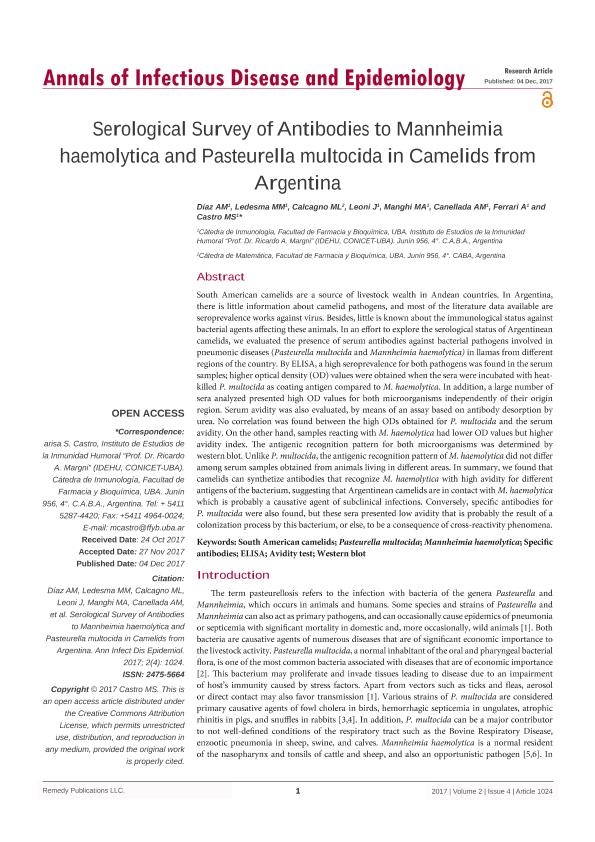Artículo
Serological Survey of Antibodies to Mannheimia haemolytica and Pasteurella multocida in Camelids from Argentina
Díaz, Ailén Magalí ; Ledesma, Martin Manuel
; Ledesma, Martin Manuel ; Calcagno, M. L.; Leoni, Juliana
; Calcagno, M. L.; Leoni, Juliana ; Manghi, Marcela Alejandra
; Manghi, Marcela Alejandra ; Canellada, Andrea Mercedes
; Canellada, Andrea Mercedes ; Castro, Marisa Silvia
; Castro, Marisa Silvia
 ; Ledesma, Martin Manuel
; Ledesma, Martin Manuel ; Calcagno, M. L.; Leoni, Juliana
; Calcagno, M. L.; Leoni, Juliana ; Manghi, Marcela Alejandra
; Manghi, Marcela Alejandra ; Canellada, Andrea Mercedes
; Canellada, Andrea Mercedes ; Castro, Marisa Silvia
; Castro, Marisa Silvia
Fecha de publicación:
12/2017
Editorial:
Remedy Publications
Revista:
Ann Infect Dis Epidemiol.
ISSN:
2475-5664
Idioma:
Inglés
Tipo de recurso:
Artículo publicado
Clasificación temática:
Resumen
South American camelids are a source of livestock wealth in Andean countries. In Argentina,there is little information about camelid pathogens, and most of the literature data available areseroprevalence works against virus. Besides, little is known about the immunological status againstbacterial agents affecting these animals. In an effort to explore the serological status of Argentineancamelids, we evaluated the presence of serum antibodies against bacterial pathogens involved inpneumonic diseases (Pasteurella multocida and Mannheimia haemolytica) in llamas from differentregions of the country. By ELISA, a high seroprevalence for both pathogens was found in the serumsamples; higher optical density (OD) values were obtained when the sera were incubated with heatkilledP. multocida as coating antigen compared to M. haemolytica. In addition, a large number ofsera analyzed presented high OD values for both microorganisms independently of their originregion. Serum avidity was also evaluated, by means of an assay based on antibody desorption byurea. No correlation was found between the high ODs obtained for P. multocida and the serumavidity. On the other hand, samples reacting with M. haemolytica had lower OD values but higheravidity index. The antigenic recognition pattern for both microorganisms was determined bywestern blot. Unlike P. multocida, the antigenic recognition pattern of M. haemolytica did not differamong serum samples obtained from animals living in different areas. In summary, we found thatcamelids can synthetize antibodies that recognize M. haemolytica with high avidity for differentantigens of the bacterium, suggesting that Argentinean camelids are in contact with M. haemolyticawhich is probably a causative agent of subclinical infections. Conversely, specific antibodies forP. multocida were also found, but these sera presented low avidity that is probably the result of acolonization process by this bacterium, or else, to be a consequence of cross-reactivity phenomena
Archivos asociados
Licencia
Identificadores
Colecciones
Articulos(IDEHU)
Articulos de INST.DE EST.DE LA INMUNIDAD HUMORAL PROF.R.A.MARGNI
Articulos de INST.DE EST.DE LA INMUNIDAD HUMORAL PROF.R.A.MARGNI
Citación
Díaz, Ailén Magalí; Ledesma, Martin Manuel; Calcagno, M. L.; Leoni, Juliana; Manghi, Marcela Alejandra; et al.; Serological Survey of Antibodies to Mannheimia haemolytica and Pasteurella multocida in Camelids from Argentina; Remedy Publications; Ann Infect Dis Epidemiol.; 2; 4; 12-2017; 1-6; 1024
Compartir



